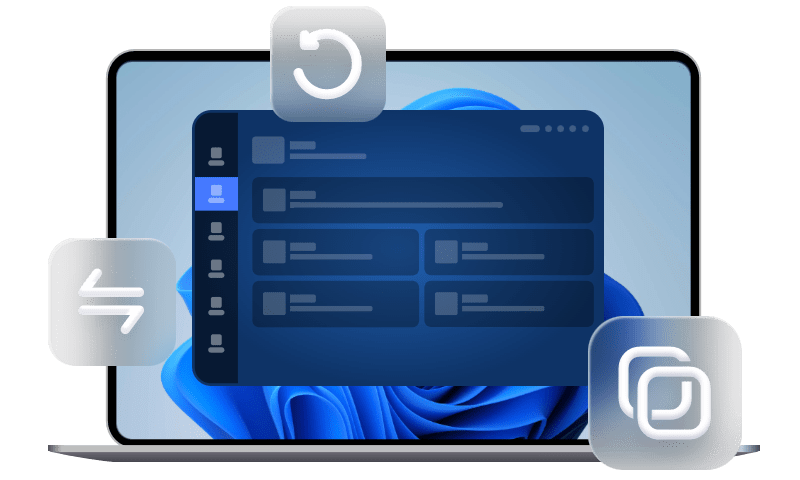How to Create Windows 10 Recovery Disk [3 Ways]
With 3 effective methods, you can create Windows 10 recovery disk to repair, reinstall, or restore your computer, even for another computer. Scroll down to pick the method that best suits your needs!
What Is a Windows 10 Recovery Disk?
A Windows 10 recovery disk is a bootable USB or DVD that contains tools to repair, reinstall, or restore your computer when you can’t load Windows normally. With it, you can:
- Fix startup problems and boot errors
- Access advanced recovery tools
- Reset Windows 10 while keeping or removing personal files
- Restore Windows 10 image to new hard drive
It’s suggested to create one when the PC is working normally, or before upgrading or replacing hardware - preferably a USB, since it’s faster, easier to boot, reusable, and works on most modern PCs.
👉 What do you need:
◾ A working Windows 10 PC (or another Windows 10 PC if yours is broken)
◾ A USB drive with at least 8GB, preferably 16GB or larger.
◾ Backup any files on the USB drive first, or you’ll lose them.
Method 1: Create Windows 10 Recovery Disk with Built-In Tool (for Current PC)
Windows 10 includes a built-in “Recovery drive” feature that lets you make a Windows 10 recovery drive without extra software. When creating the drive, it includes the option to check “Back up system files to the recovery drive”, which allows a full reinstall of Windows, not just troubleshooting tools.
Step 1. Search recovery drive in the Start menu and open it.
Step 2. Be sure the option - Back up system files to the recovery drive is checked. Click Next.
Step 3. Select USB flash drive and click Next.
Step 4. Plug in a USB drive (16GB or larger), click Refresh, and select it
Step 5. Click Create. It will start to copy system files and create a Windows 10 recovery disk.
Sometimes, users find they are unable to create recovery drive on Windows 10, and this may be due to different reasons, such as corrupted recovery partition, insufficient space, improper formatting, missing system files, disabled WinRE, etc., click to learn more.
Method 2: Create Windows 10 Installation Media (for Another Computer)
If your PC is already broken, missing recovery files, or you want a tool that works on multiple computers, creating Windows 10 installation media is the best option.
Step 1. Download Windows 10 MediaCreationTool from Microsoft. Double-click .exe file to run it and accept the license agreement.
Step 2. Check Create installation media (USB flash drive, DVD, or ISO) for another PC and click Next.
Step 3. Choose the language, edition, and architecture (usually “Windows 10” and “64-bit”)
Step 4. Pick USB flash drive as the installation media. Be sure to select your USB drive to save installation files.
Method 3: Create Windows 10 Bootable USB using Universal Tools (Complete Recovery)
AOMEI Backupper Standard is a universal tool that can help you bring your computer back to life easily and quickly. It can create Windows 10 bootable USB, CD/DVD, ISO files, and boot any compatible PCs, supporting both UEFI and Legacy modes.
What’s more, it integrates full backup solutions and allows you to restore everything, not just Windows, but also programs, settings, and your personal data, with minimal manual intervention. Compared to reinstalling Windows 10, it is faster and more straightforward, eliminating the need for extra software.
Step 1. Download, install, and launch AOMEI Backupper Standard on a working PC. Then, go to Tools > Create Bootable Media.
Step 2. Select USB Boot Device and your drive (from the drop-down menu). Click Create.
👉 How to create a system image in Windows 10?
◾ Open AOMEI Backupper. Click Backup and System Backup.
◾ Click the PC icon to select the backup destination.
◾ Confirm and click Start Backup. For long-term data protection, click Schedule to set an automatic backup task.
How to Boot From a Windows 10 Recovery Disk
After creating a Windows 10recovery USB or installation media, it’s necessary to make sure the computer can boot from it. Most PCs won’t do this automatically- you have to change the boot order.
Step 1. Leave the USB plugged in. Restart your computer and immediately press the key (e.g., F2, F12, Del, Esc, F10) to enter the BIOS/UEFI settings window.
Step 2. Under the Boot tab, move the USB drive to the first boot option. Then, press F10 to save changes and restart. The PC should now boot from the USB and show recovery options.
What’s the Difference between Recovery Drive and Installation Media?
Recovery drive and installation media both include repair tools and the ability to reinstall Windows 10. However, they differ in the following aspects, as detailed in the table below:
|
Feature |
Recovery Drive |
Installation Media |
|
Created from |
Your PC (tied to the original PC) |
Microsoft’s MediaCreationTool |
|
Repair tools |
✅ |
✅ |
|
Full Windows setup |
Optional (Only if system files are included) |
✅ |
|
Keeps personal files & apps |
❌ |
❌ |
|
Unbootable PC |
✅ |
✅ |
|
Works on any compatible PC |
❌ |
✅ |
|
👑 Best for |
Your current PC |
Any compatible, unbootable PCs |
💡 Note: The recovery disk created by AOMEI Backupper allows a full system image recovery, covering not only Windows but also applications, personal data, and more. It eliminates the need for extra software, making the process easier.
FAQs About Creating a Windows 10 Recovery Disk
1. Does a recovery disk save my personal files?
No. A recovery disk helps repair or reinstall Windows, but it does not back up your personal data. You can choose to reset Windows 10 while keeping user files or perform a system image recovery (with OS and all data).
2. How big should the recovery USB be?
Most systems need 16GB. Some newer PCs may require 32GB if backing up system files.
3. Can I use a recovery disk on another computer?
Usually no. A recovery drive is tied to the original system’s hardware. For another PC, use the Windows installation media instead.
4. What if my PC won’t create a recovery drive?
Use the MediaCreationTool to make installation media, or create a bootable USB using AOMEI Backupper, a universal tool, especially useful for system image recovery.
5. Do I need a recovery disk if I already have installation media?
Not always. Installation media can repair or reinstall Windows, but a recovery drive may include system-specific files and factory features.
6. Will the recovery drive erase my USB?
Yes. The tool formats the USB first. Always move or back up anything stored on the drive before creating it.
Final Thoughts
Every user should create a Windows 10 recovery disk before Windows won’t start, not after. You can then use it to repair or reinstall Windows 10 quickly. The Recovery drive is for quick repairs, while installation media works for any compatible PCs.
In addition, to restore Windows, files, and apps exactly as they were, it is essential to create a system image backup in Windows 10 exactly as they were- beyond just the recovery disk. AOMEI Backupper, a universal tool, integrates all of them in one software and simplifies the entire process.

